- K-State home
- K-State Salina
- Academics
- Degree Options
- Professional Pilot
- K-State Aerospace and Technology Campus Fleet
K-State Aerospace and Technology Campus Fleet
All K-State pilot students have access to three hangars, more than 30 aircraft - mostly built in the state of Kansas - and a bank of flight simulators with visual displays.
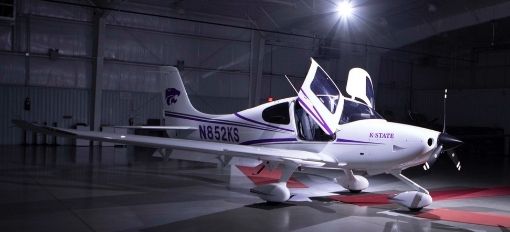
Cirrus SR20
Some of the newest aircraft to the fleet at Kansas State University Salina Aerospace and Technology Campus are the SR20s from Cirrus. Through its strategic partnership with Cirrus Aircraft, K-State Salina now has five new Cirrus SR20s featuring innovative systems, including electronic stability and protection and the Cirrus Airframe Parachute System, or CAPS, as an added protective layer for pilot and passengers. The addition of the high-performance Cirrus aircraft will provide students with the advanced-aviation training needed to become safe, professional pilots. A noticeably "smooth" ride, the SR20 features over 200 horsepower and is equiped with Garmin avionics giving the student pilots improved situational awareness while flying. The SR20 is a steppingstone between the Cessna 172 and the Baron G58 to allow students to learn how to manage the power jump between the two aircraft and allows them to train on a different type of aircraft.
Specifications
| Performance | |
| Takeoff | 1,685 ft. (514 m) |
| Climb Rate | 781 ft/min (3.97 m/sec) |
| Max operating Altitude | 17,500 ft (5,334 m) |
| Stall Speed with Flaps | 57 KCAS |
| Max Cruise Speed | 155 KTAS |
| Landing Groundroll | 853 ft (260 m) |
| Weights | |
| Base Weight | 2122 lbs (960 kg) |
| Useful Load | 1028 lbs (469 kg) |
| Cabin payload with 3 hr trip fuel and 45 min reserve |
774 lbs (354 kg) |
| Dimensions | |
| Wingspan | 38 ft 4 in (11.68 m) |
| Length | 26 ft (7.92 m) |
| Height | 8 ft. 11 in (2.7 m) |
| Cabin Width | 49 in (124 cm) |
| Cabin Height | 50 in (127 cm) |
| Engine | |
| Manufacturer | Lycoming |
| Model | IO-390-C3B6 |
| Horsepower | 215 |

Cessna 172
Students at Kansas State University Salina Aerospace and Technology Campus begin their private pilot flight training in the 160-horsepower Cessna 172 Skyhawk. The Cessna 172 has proven to be one of the most versatile, reliable and safest training aircraft. The Skyhawk is a native aircraft to Kansas produced in Wichita.
All of our Skyhawks are outfitted with Automatic Dependent Surveillance-Broadcast system and half are outfitted with Garmin G1000 glass cockpit. This system allows students and instructors to see real-time weather and traffic alerting on the flight deck. Flight Operations also has a link to monitor the actual location of every aircraft in the fleet at any given time.
The real value of the Skyhawk in training is its inherent stability and structural integrity, allowing it to take anything flight training is willing to throw at it. Day after day, the Cessna 172 Skyhawk is ready to provide our students and instructors with the best flight training experience available.
Specifications
| Speeds | |
| Maximum speed at sea level | 124 knots |
| Cruise, 75% power at 8,000 feet | 123 knots |
| Stall speed, flaps up | 48 knots |
| Stall speed, flaps down | 40 knots |
| Performance | |
| Range, 75% power at 8,000 feet | 515 nautical miles |
| Endurance (time) | 4.2 hours |
| Rate of climb at sea level | 730 feet per minute |
| Service ceiling | 13,500 feet |
| Weights and loads | |
| Maximum ramp weight | 2,558 pounds |
| Maximum takeoff or landing weight | 2,550 pounds |
| Baggage allowance | 120 pounds |
| Fuel | |
| Fuel capacity | 56 gallons |
| Usable fuel | 53 gallons |
| Engine and propellor | |
| Engine | Textron |
| Propellor | Fixed pitch, diameter 75" |
| Oil capacity | 8 quarts |

Baron 58
Students at Kansas State University Salina Aerospace and Technology Campus complete their Multi-Engine Flight training in the 600-horsepower (two 300-HP engines) Beechcraft Baron 58. The Baron is a versatile airplane with room for six, has large cargo doors, and can cruise at more than 200 knots. The Baron 58 is a native aircraft to Kansas and is currently produced in Wichita.
The real value of the Baron 58 in training is its state-of-the-art technology that prepares students for the challenges of flying bigger and more complex aircraft. The Beechcraft Baron 58 has proven itself day after day to prepare students for the commercial and flight instructor certificates.
Specifications
| Speeds | |
| Maximum speed at sea level | 202 knots |
| Cruise, 75% power at 8,000 feet | 195 knots |
| Stall speed, flaps up | 83 knots |
| Stall speed, flaps down | 73 knots |
| Performance | |
| Range, 75% power at 8,000 feet | 1,520 nautical miles |
| Endurance (time) | 7.4 hours |
| Rate of climb at sea level | 1,700 feet per minute |
| Service ceiling | 18,500 feet |
| Weights and loads | |
| Maximum ramp weight | 5,524 pounds |
| Maximum takeoff weight | 5,500 pounds |
| Baggage allowance | 700 pounds |
| Fuel | |
| Fuel capacity | 200 gallons |
| Usable fuel | 194 gallons |
| Engine and propellor | |
| Engine | Two continental engines |
| Propellor | Two constant speed, diameter 77" |
| Oil capacity | 12 quarts |
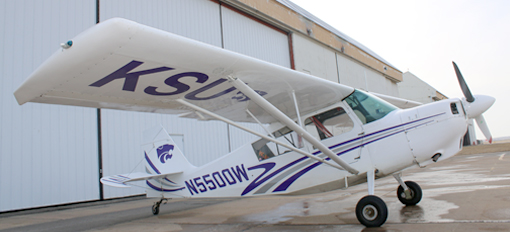
Super Decathlon
Students at Kansas State University Salina Aerospace and Technology Campus have the option of completing a course which teaches them the right way to handle extreme conditions in an upset recovery course. This course uses a fully capable aerobatic certified American Champion Super Decathlon.
The Decathlon is the perfect aircraft to learn how to recover from extreme unusual attitudes, spins, and even learn how to land a tailwheel airplane. The upset recovery course will also include some basic aerobatics. This is specialized training that you will be happy to have, but hopefully will never need to use.
Specifications
| Speeds | |
| Maximum speed at sea level | 155 mph |
| Cruise, 75% power | 147 mph |
| Stall speed | 53 mph |
| Performance | |
| Loading | +6, -5 Gs |
| Endurance (time) | 4.4 hours |
| Service ceiling | 15,800 feet |
| Weights and loads | |
| Maximum ramp weight | 1,800 pounds |
| Useful load | 460 pounds |
| Fuel | |
| Usable fuel | 39 gallons |
| Engine and propellor | |
| Engine | Lycoming 180 horsepower |
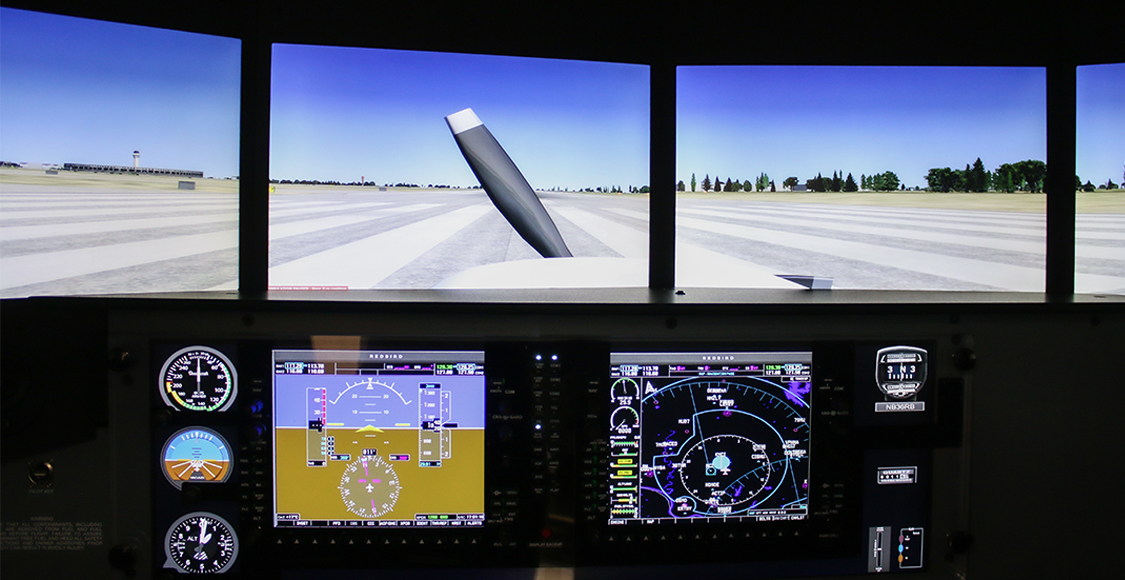
Redbird Flight Training Devices
K-State Aerospace and Technology Campus provides students with the opportunity to train on two Redbird flight simulators. The Redbird simulator is a flight training device that allows students to accumulate flight time in an economical way.
The Redbird simulator allows students to train in any environment, such as mountains, inclement weather, various airfields/airports, etc. The simulator allows students to focus their attention to in-flight training, with no pre-flight checks and no waiting for other aircraft to taxi. Students and instructors are also able to pause the simulator mid-flight to have a conversation or teaching moment, allowing students to learn in the moment.
When using the Redbird simulator, students can train on various types of aircraft. K-State Aerospace and Technology trains on the Skyhawk 172, both G1000/glass cockpit and steam gauge; Bonanza G36 and Baron.
Using the Redbird simulator allows students to practice for emergencies such as electrical failure, engine failure, gear failure and more. Students are also able to practice navigating with instruments prior to flying in aircraft.
Specifications
| Component | Description |
| Exterior shell | Aluminum cockpit enclosure. |
| Primary flight control | Dual Control Loading yoke system. |
| Rudder pedals | Dual rudder pedals with differential brakes. |
| Throttle quadrant | Controls for throttle, propeller, and mixture as appropriate to aircraft being simulated. Interchangeable depending on aircraft configuration. |
| Avionics panel | Controls for flight instruments, GPS(s), radio(s) and autopilot as appropriate to aircraft being simulated. Interchangeable depending on aircraft configuration. |
| Dimensions | 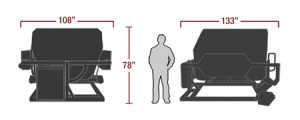 |
*Specifications courtesy of Redbird flight website.
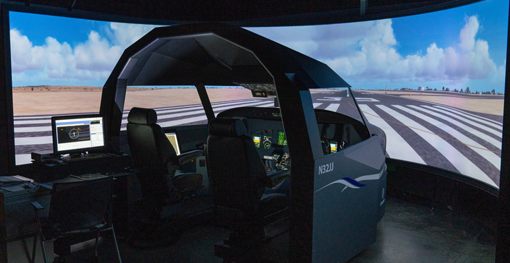
L3 Harris Technologies Flight Training Devices
Our L3 Harris Technologies flight training devices, commonly known as simulators, feature both a full trainer (FTD) and two flat-panel trainers (EFPTs). These simulators provide students hands-on knowledge on how to use an automated flight deck, how highly complex systems integrate with each other, and how crews interact in the decision-making process.
These devices can recreate almost any situation, which can help students improve their navigational abilities under both visual and instrument flight rules. Faculty can load a flight from a chosen airport with real-world runway layouts, accurate terrain features and weather conditions.
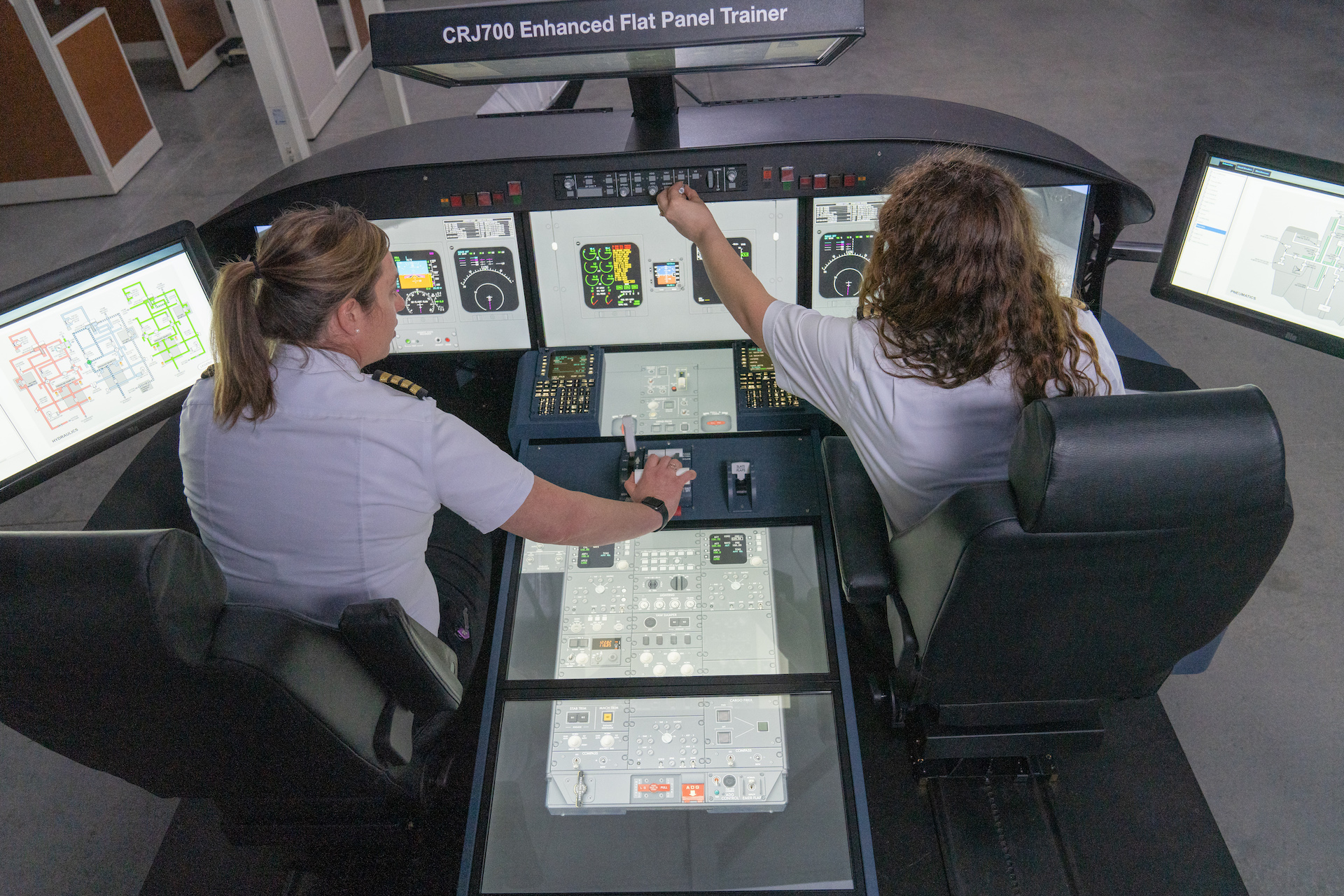
Flat-panel training device